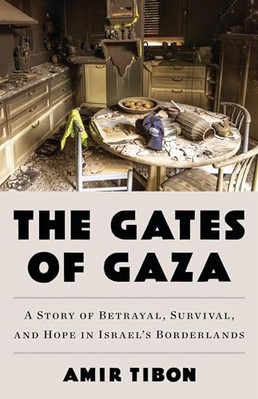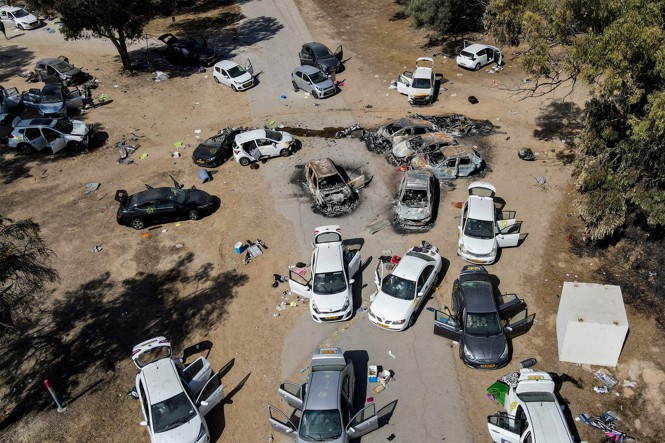How My Father Saved My Life on October 7
The day started with a whistle—a short, loud shriek coming through our bedroom window. I didn’t wake up; the noise, otherworldly but familiar, blended into my dreams. Miri, my wife, was quicker to realize the danger: “Amir, wake up, a mortar!” We leaped out of bed and sprinted down the hall toward our safe room, a thick concrete bunker, wearing only underwear.
Every house in our kibbutz, Nahal Oz, has a safe room. We live less than a mile from the border with the Gaza Strip—close enough that Israel’s Iron Dome doesn’t have time to intercept artillery aimed at us. When Hamas launches a mortar, we have seven seconds before it lands.
As soon as we shut the heavy iron door, an explosion shook the house. Then a second, and a third. Our two daughters, who sleep in the safe room, had been through this many times before. Three-year-old Galia didn’t even stir. Carmel, nearly 2, raised her head but fell back asleep once she found her pacifier.
 This article has been adapted from Tibon’s new book.
This article has been adapted from Tibon’s new book.
It was 6:30. Miri and I took out our phones and quickly discovered that Hamas was firing on dozens of locations across Israel. Whenever violence breaks out, we immediately start packing suitcases so that we can leave the kibbutz at the first moment of quiet. Israel and Hamas would typically announce a cease-fire within 10 days, at which point we’d return and get on with our lives.
But as we were packing, Miri and I heard a sound that told us this time would be different: gunfire. It started in the fields and steadily got closer. Then we heard shouting in Arabic outside our house—a commander telling one of his men to try to break in.
We had woken up to a nightmare: The border had been breached. Hamas was here.
When we moved to Nahal Oz in 2014, no word terrified us more than tunnel. Earlier that year, Hamas had used its extensive underground network to cross the border and kill Israeli soldiers. In response, the government invested more than $1 billion in an underground border wall, digging as deep as 160 feet. Any threat of an invasion had apparently been eliminated: The military began withdrawing soldiers from the borderlands, including from the base a few minutes’ drive from our home. The aboveground border fence, equipped with security cameras and machine guns, was supposed to be impenetrable.
On the morning of October 7, fewer than four full battalions guarded the border with Gaza. (Compare that with the roughly 25 battalions posted in the West Bank.) About 200 soldiers were stationed at the nearby base. It wasn’t nearly enough. Thousands of Hamas fighters bulldozed, blew up, and broke through the fence. Drones had prepared the way by destroying its guns and cameras. By 8:30 a.m., terrorists had captured the base, killing dozens of soldiers. In recent weeks, those soldiers had told their commanders that they had seen Hamas storming large-scale models of Israeli kibbutzim—an obvious dress rehearsal. But their warnings were dismissed. Israel’s leaders didn’t think Hamas would be willing to start a war.
[Read: ‘We’re going to die here’]
Even with the local base out of commission, Nahal Oz wasn’t entirely undefended. The kibbutz has a small security team that was heading off Hamas despite being outnumbered. But there was no chance of a military force arriving quickly enough to save us from the immediate danger. Mercifully, perhaps, Miri and I remained unaware. All we could do was wait.
Within minutes of the base being overrun, I got a call from my father. Cell reception in the safe room was spotty—it would soon go out for good—but I had been able to text him explaining that we were trapped. Our call was brief. He offered me the only words of hope that I would hear for hours: “We’re coming to get you out of there.”
While my mother drove him from Tel Aviv, my father, a retired army general, called all the senior military officials he knew—the army’s chief of staff, the head of the Southern Command, the commander of the Gaza regional division. None answered, so he texted instead, warning them that terrorists were inside Nahal Oz. He received just one response: “I know.”
Rockets flew overhead as my parents entered the border region. My father put down his phone and took out a pistol. Once they got to Sderot, about 15 minutes from Nahal Oz, they saw a police cruiser parked sideways, blocking the highway. Policemen took cover behind it, shooting at some enemy my parents couldn’t see. My mother was preparing to make a U-turn when a young couple darted in front of the car. They were out of breath and—as my father recalled—“dressed for a party.” He and my mother hurriedly let them in.
As my mother drove away, the couple told my parents that they had come from a music festival. “They shot everyone,” the woman exclaimed. “Everyone’s dead.” My parents listened in terror, imagining what might be happening to us in Nahal Oz. They drove the young couple to safety and turned back for the border.
 The aftermath of Hamas’s attack on the music festival (Jack Guez / AFP / Getty)
The aftermath of Hamas’s attack on the music festival (Jack Guez / AFP / Getty)
About eight miles from Nahal Oz, my mother suddenly stopped the car in disbelief. Dozens of corpses covered the highway: Israeli soldiers and policemen, civilians, Hamas fighters. Most of the cars were charred; some were overturned. Others were still running but empty inside. My father was stunned. He had served in the Israel Defense Forces for more than three decades, even operating behind enemy lines. And yet, he told me, “I’ve never seen so much death in one place before.” My mother nosed the car forward, slowly steering between bodies.
Within a few minutes, at around 10:30 a.m., my parents had to stop again. They had driven into their second firefight of the day. A soldier directed them to take cover in a nearby bomb shelter, where they discovered a heap of mutilated remains: Hamas had chased Israelis there from the festival and thrown in grenades.
As my parents walked outside in horror, three armored vehicles carrying Israeli special forces were approaching. My father was able to persuade one of the officers, Avi, to go with him to Nahal Oz. My mother stayed behind, knowing that the next phase of the journey would be the most dangerous.
Meanwhile, Miri and I were desperately trying to keep the girls quiet. We pretended to be calm for their sakes, knowing that Hamas fighters might be close enough to hear them if they cried. But around noon, when Galia and Carmel fell back asleep, we stopped pretending. The military still hadn’t come, and we had lost contact with my father. I whispered to Miri that this was all my fault; it had been my idea to live in Nahal Oz. She tried to console me, saying that she loved our life here. “We both chose this place.”
Then, briefly, my cell reception returned. It was my mother: “Dad is getting closer to you.”
My father and Avi were two miles from the border when they heard shots up ahead. Hamas fighters had ambushed a group of IDF soldiers and pinned them behind their Jeep Wrangler. My father and Avi jumped out of their car and ran toward the soldiers. A brigade of Israeli paratroopers arrived at the same time, opening fire on the Hamas fighters as my father made it to the Wrangler. He found five commandos there—two on his right pleaded for ammunition; three on his left stayed silent. Once he realized they were dead, he stripped their ammo and threw it to the survivors. Then he took an M16 for himself and killed a Hamas fighter who was rushing the car. The Israeli soldiers shot at the ambushers until the enemy fire abated. Silence fell over the forest, and one of the paratroopers announced that he’d been hit. My father ran over and saw that he’d been struck in the stomach.
[Franklin Foer: The war that would not end]
By now my father understood, based on all the violence he’d seen, that reinforcements had not likely gotten to Nahal Oz. He faced a painful decision: The kibbutz lay within reach, but the paratrooper wouldn’t survive unless he was evacuated immediately.
My father made the right choice. He saved the soldier, taking him back to my mother, while Avi and the others stayed behind to hunt for remaining Hamas fighters. She drove the paratrooper to a nearby hospital, leaving my father stranded without a car. By some miracle, he ran into a general he knew, Israel Ziv, who agreed to drive him to Nahal Oz.
Their way was clear. More than six hours after leaving home, my father reached the kibbutz. Along the perimeter fence, he encountered a group of soldiers who agreed to let him join their command. An armored vehicle pulled up, carrying the local security team that had been defending Nahal Oz on its own all day. My father listened anxiously as they reported that roughly two dozen Hamas fighters remained in the kibbutz. The terrorists had broken into at least several homes, but the security team didn’t know how many. Then another group of IDF soldiers arrived, making my father one of about 70 fighters assembled on the eastern edge of Nahal Oz. They divided themselves into teams and started searching every building in the kibbutz.
 Smoke rises from the Gaza Strip on January 30, 2024, seen behind a gap in the fence bordering Nahal Oz. (Sam McNeil / AP)
Smoke rises from the Gaza Strip on January 30, 2024, seen behind a gap in the fence bordering Nahal Oz. (Sam McNeil / AP)
It was now around 2 p.m., but Miri and I had no way of knowing. Our phones had long since died, and the room was too dark for me to read my watch. The only light came from Carmel’s glow-in-the-dark pacifiers.
We heard gunfire again, this time in the distance: short, disciplined bursts, nothing like Hamas’s wild shooting from the morning. Miri and I felt a glimmer of hope. Maybe the military had finally come.
Making his way through the kibbutz, my father saw bodies everywhere: in the road, in yards, in driveways, in houses. Most were Hamas fighters. Many still held their weapons. By 4 p.m., he had reached our property. Everything in sight had bullet holes—the house, our two cars, our stroller. A dead terrorist lay on the front porch with a rocket-propelled grenade in his hand, pointed at our next-door neighbors. Two others blocked the sidewalk in front of our door. Another had died next to our lemon tree.
My father walked up to the exterior wall of the safe room, took a deep breath, and smacked the covered window. We heard a bang and then a familiar voice. The air inside was hot and thick by then; we worried that we were running out of oxygen. Galia was the first to speak. “Saba is here,” she said simply, using the Hebrew word for grandfather. I could hear the exhaustion in her voice, but for the first time in hours, she sounded happy.
My father shouted for us to open the front door. It took me a second to start moving. I imagined a terrorist hiding in the house, waiting for me to emerge. Slowly I felt my way through the darkness and opened the safe-room door. The light was overwhelming. I covered my eyes and crept to the front of the house toward my father. We embraced as soon as he stepped in the door. For a few moments, we stood there silently, holding each other.
By evening, the soldiers had finished searching the kibbutz and killed almost 30 Hamas fighters. They had found the bodies of 15 of our neighbors, including a family who were clinging to one another in their safe room when terrorists broke in.
The kibbutz would be evacuated soon, but in the meantime, the soldiers began assembling survivors in our house. By 7 p.m., we had more than 40 people inside, including about 10 young children huddled in the safe room. Rumor spread that those of us who were missing had been kidnapped and smuggled into Gaza.
In the midst of all this, Ruti, a woman who lived across the street, asked Miri where she could find a pot for cooking. Miri seemed confused: “What are you talking about?” But Ruti insisted. “I know we’ve all had a very long day, but there are 10 children sitting in that little room, and they need to have dinner.”
Miri accompanied Ruti to the kitchen. With the help of another neighbor, they made pasta for everyone in the house. As I watched people eating—the children in the safe room, their parents in the living room, and the soldiers on the porch, visible through the cracks that bullets had left in our windows—I realized that Ruti was doing more than feeding us. She was telling us, in very few words, that because we were alive, we were going to have to live.
This article has been adapted from Amir Tibon’s new book, The Gates of Gaza: A Story of Betrayal, Survival, and Hope in Israel’s Borderlands.


